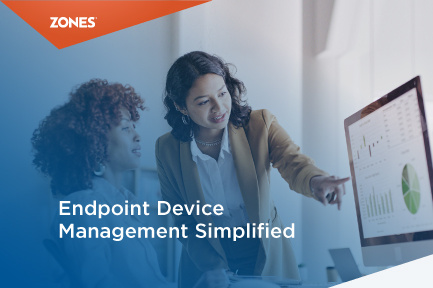Advanced mobility management solutions enable a more secure mobile enterprise
Take a comprehensive approach to business mobility The growth of mobile infrastructures in organizations is creating the most connected workforce...
6 min read
Dave Hunt : Jul 17, 2024 2:08:15 PM

In today's digital-first world, organizations face challenges in managing the increasing number of devices across their technology ecosystems. Enterprise IT assets have become diverse and intricate, from traditional desktops and laptops to smartphones, tablets, and IoT devices. This increase in devices has created a pressing need for robust, flexible, and comprehensive device management solutions.
Effective device management is important for organizations to maintain security, productivity, and compliance across the entire technology infrastructure.
As the complexity of device ecosystems has grown, so too have the approaches to managing them. Organizations face challenges in choosing their device management strategy between modern cloud-based solutions like Microsoft Intune or traditional device management approaches.
This selection is not merely a matter of technological preference; it also impacts your organization's operational efficiency, security posture, and ability to adapt to future challenges. To make an informed decision, it's essential to understand how device management has evolved over time and the strengths and weaknesses of different approaches.
The history of device management in enterprise settings reflects the rapid advancement of technology and the changing needs of organizations. Let's examine this evolution to provide context for our comparison of Microsoft Intune and traditional device management solutions.
In this period, IT departments manually configured and managed devices, often relying on physical access to make changes. This approach was time-consuming, error-prone, and lacked scalability. Organizations struggled with inconsistent configurations and security vulnerabilities.
The rise of centralized management tools marked this era. Solutions focused primarily on inventory management, software distribution, and basic security policies. These tools often required significant on-premises infrastructure and were limited in their ability to manage diverse device types.
As smartphones and tablets entered the workplace, MDM solutions emerged to address the unique challenges of mobile devices. These tools provided remote management capabilities, app distribution, and basic security features for mobile platforms. However, they often existed as separate solutions from traditional PC management tools.
EMM expanded on MDM capabilities to include mobile application management (MAM) and mobile content management (MCM). This holistic approach allowed organizations to secure not just devices but also the apps and data residing on them. EMM solutions began to bridge the gap between mobile and traditional device management.
UEM represents the convergence of traditional device management, MDM, and EMM into a single, comprehensive solution. UEM platforms like Microsoft Intune aim to provide a unified approach to managing all endpoints – from smartphones and tablets to laptops, desktops, and even IoT devices – through a single console and management framework.

Source: Codeproof
According to Global Information Research, the unified endpoint device management market is expected to reach USD 21.79 billion by 2030. This highlights the significance of UEM in the current and future times as part of the organizational device management strategies.
With this historical context in mind, let's delve into a detailed comparison of two primary approaches to device management: Microsoft Intune and traditional device management solutions.
Microsoft Intune is a cloud-based unified endpoint management solution that is a part of Microsoft's Enterprise Mobility + Security (EM+S) suite. It provides comprehensive device management capabilities for mobile devices, desktops, and apps across various platforms.
One of Intune's strongest advantages is its deep integration with Microsoft 365 services, offering a cohesive experience. This integration extends beyond the basic device management to include features like Conditional Access, Application Protection, and Cloud-Based Device Management.
Today, over 60% of Fortune 500 companies use Microsoft 365, making Intune a natural choice for many organizations looking to streamline their device management strategy.
Intune's cloud-based approach eliminates the need for on-premises infrastructure, reducing costs and complexity. It comes with automatic updates and can scale easily to accommodate growing device numbers without additional infrastructure investments.
Intune offers advanced endpoint analytics to provide data-driven insights for measuring the quality of the end-user experience.
Intune offers a single console for managing all types of devices, including Windows, macOS, iOS, and Android. This unified approach streamlines administration and improves visibility across the entire device ecosystem.
Intune leverages Microsoft's security expertise, offering features like advanced threat protection, access management, and multi-factor authentication via its integration with Microsoft Defender for Endpoint.
As a cloud service, Intune benefits from regular updates, security patches, and new features. Microsoft typically releases updates every month, ensuring that your organization always has access to the latest capabilities.

Source: Microsoft
For organizations new to the Microsoft ecosystem, there can be a significant learning curve. Intune comes with complex configuration and integration setup, which may require your IT team to learn additional skills.
Being cloud based, Intune requires consistent internet connectivity for optimal functionality. This can be a challenge if your organization operates in remote locations or locations with limited internet access. It may also impact processes of device enrollment, policy changes, and configurations, as well as real-time reporting in Intune if your internet connection is largely unstable.
Intune's licensing model is complex as there are multiple licensing options (standalone or as part of various Microsoft 365 and Enterprise Mobility + Security (EM+S) plans). Additionally, licensing is available based on users and devices. Your organization may need to navigate various subscription options to find the right fit for your needs.
Traditional MDM or traditional device management refers to on-premises or hybrid solutions that have been used for years to manage organizational devices. These solutions are offered by various vendors and often focus on specific device types or operating systems.
Traditional MDM solutions have a longer history in the market, with proven reliability and a well-established knowledge base and community.
Traditional device management solutions offer highly granular control over device settings and policies. This can be beneficial for organizations with specific compliance requirements or unique use cases. Additionally, these device management solutions offer better support for older operating systems and device types.
For organizations with strict data sovereignty requirements or those in heavily regulated industries, traditional device management solutions often provide on-premises deployment options. This helps with better data management and security within your organization’s infrastructure.
Some traditional device management solutions provide platform-specific capabilities and are quick to adopt with tailored features. This helps obtain specialized support and expert assistance.
Unlike Intune, traditional device management solutions often lack deep integration with productivity suites and other enterprise applications. This can result in siloed management and reduced overall efficiency.
On-premises device management solutions require dedicated hardware and ongoing maintenance, leading to a higher total cost of ownership (TCO). Additionally, it requires separate database licenses and servers for hosting, which may increase IT overheads significantly.
Traditional solutions typically have longer release cycles for updates and new features. This can leave organizations vulnerable to emerging security threats and limit access to cutting-edge capabilities. Moreover, manual updates can be time-consuming and disruptive.
As device ecosystems become more diverse, traditional device management solutions may struggle to provide unified management across all platforms. This can lead to increased complexity and management overhead.
-jpg.jpeg?width=743&height=389&name=Dave-Hunt-Quote%20(1)-jpg.jpeg)
When deciding between Microsoft Intune and a traditional device management solution, consider the following factors:
Both Microsoft Intune and traditional device management solutions have their strengths and weaknesses. While Intune offers cloud-native advantages, seamless Microsoft integration, and rapid innovation, traditional solutions offer reliability, granular control, and on-premises options.
As the device management landscape continues to evolve, organizations must carefully evaluate their specific needs and choose a solution that aligns with their long-term strategy. With the right approach, you can ensure robust security, streamlined management, and enhanced productivity across your entire device ecosystem.
While choosing between Microsoft Intune and traditional device management solutions is crucial, making an informed decision requires a comprehensive understanding of your current IT infrastructure. This is where Zones ITAM Solutions can play a pivotal role. Zones ITAM Solutions is a non-intrusive, agentless technology designed to provide in-depth IT infrastructure insight, discovery, and analytics. It offers a single-pane-of-glass view to detect, itemize, and track everything on your network – from desktops to data centers and beyond. With its ability to collect detailed information across multiple platforms, conduct software inventory and usage metering, and provide comprehensive hardware reporting, Zones ITAM Solutions can help you accurately assess your current environment.
These insights from Zones ITAM Solutions can guide your decision-making process when selecting between Intune and traditional MDM solutions, ensuring that your choice aligns perfectly with your organization's specific needs and existing infrastructure.
Additionally, Zones can help you in Device Endpoint Management Implementation by assessing your organization's unique requirements and implementing the ideal device management solution: Microsoft Intune, a traditional platform, or a hybrid approach.
Don't let device management complexities hold your business back. Discover how our tailored device management services can transform your organization's technology strategy.

Take a comprehensive approach to business mobility The growth of mobile infrastructures in organizations is creating the most connected workforce...

The Multi-Cloud managed services industry has experienced significant growth in recent years, and this trend is set to continue as organizations...

Today, businesses face dual pressures to maximize technology investments while navigating complex security regulations and environmental...